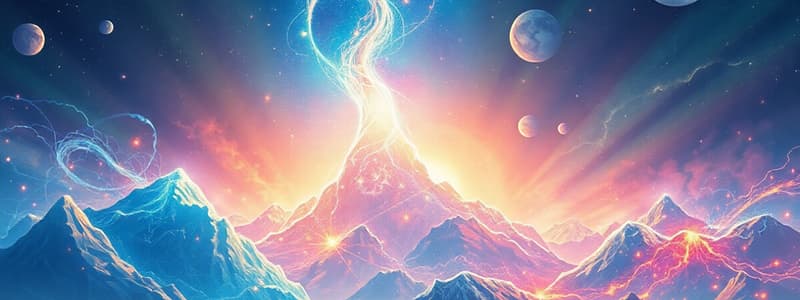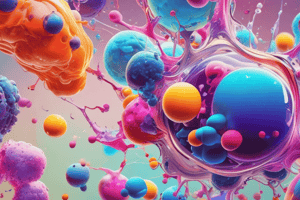Podcast
Questions and Answers
What does the Law of Conservation of Matter state?
What does the Law of Conservation of Matter state?
- Matter can be created but not destroyed.
- Matter is always conserved in a chemical reaction.
- Matter can change forms but is not created or destroyed. (correct)
- Matter can be created or destroyed.
Which type of energy is characterized as stored energy?
Which type of energy is characterized as stored energy?
- mechanical Energy
- Kinetic Energy
- Potential Energy (correct)
- Nuclear Energy
What is a characteristic of a homogeneous mixture?
What is a characteristic of a homogeneous mixture?
- Settles into layers over time.
- Components are easily distinguishable.
- Different composition throughout.
- Consistent composition throughout. (correct)
Which of the following is an example of an extensive property?
Which of the following is an example of an extensive property?
Which statement about compounds is true?
Which statement about compounds is true?
What type of energy results from the movement of electrons?
What type of energy results from the movement of electrons?
Which of the following is a characteristic of intensive properties?
Which of the following is a characteristic of intensive properties?
Which of the following elements is a liquid at room temperature?
Which of the following elements is a liquid at room temperature?
Flashcards are hidden until you start studying
Study Notes
Matter
- Anything with mass and volume
- Law of Conservation of Matter: Matter is neither created nor destroyed
Energy
- 9 forms of energy
- Law of Conservation of Energy: Energy is not created or destroyed, just converted from one form to another
- Kinetic Energy: Energy of motion
- Potential Energy: Stored energy
- Mechanical Energy: Combination of potential and kinetic energy
- Sound Energy: Energy that travels as vibrations
- Chemical Energy: Energy stored in chemical bonds
- Released when bonds form
- Absorbed when bonds are broken
- Light Energy: Electromagnetic radiation
- Heat Energy: Energy transferred due to temperature differences
- Solar Energy: Energy from the sun
- Nuclear Energy: Energy released from the nucleus of an atom through fission or fusion
- Formula: E=mc2 (energy equals mass times the speed of light squared)
- Electrical Energy: Energy associated with the movement of electrons
Substance
- Matter made up of only one type of matter, always homogeneous
Elements
- Found on the periodic table
- Building blocks of all matter
- 118 elements
- Majority are metals
- Gases: Noble Gases (Group 18)
- Examples: H2, O2, F2, Cl2, N2
- Liquids:
- Liquid Metal: Mercury (Hg)
- Liquid Non-metal: Bromine (Br)
- Solids: All other elements
- Gases: Noble Gases (Group 18)
Compounds
- Two or more elements chemically combined
- Acquire entirely new chemical and physical properties
- Law of Definite Proportions: Every sample of the same compound has the same ratio of elements
- Law of Multiple Proportions: Same elements can combine to form multiple different compounds
- Examples: CO (Carbon Monoxide) and CO2 (Carbon Dioxide)
Mixture
- Two or more substances physically combined
- Each substance retains its original properties
Homogeneous Mixture
- Uniform throughout
- Solute is dissolved
- Also known as solutions
- Examples: Saltwater, sugar water, air
- Alloys: Solid solutions
- Examples: Bronze, Steel, Brass
Heterogeneous Mixture
- Non-uniform throughout
- Composition varies depending on the sample location
- Examples: Sand in water, salad dressing, soil, blood, milk
Properties of Matter
Intensive Properties
- Do not change with the size of the sample
- Examples: Density, pH, color, hardness, luster (shine), malleability
Extensive Properties
- Change with the size of the sample
- Examples: Mass, Volume, Weight, Surface area, Amount of Matter
- Dependent on gravity
Studying That Suits You
Use AI to generate personalized quizzes and flashcards to suit your learning preferences.




